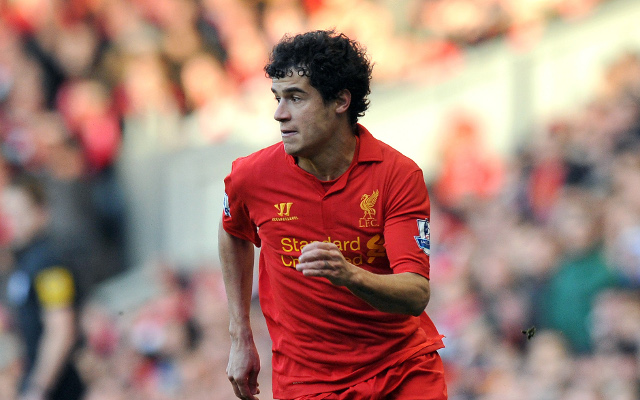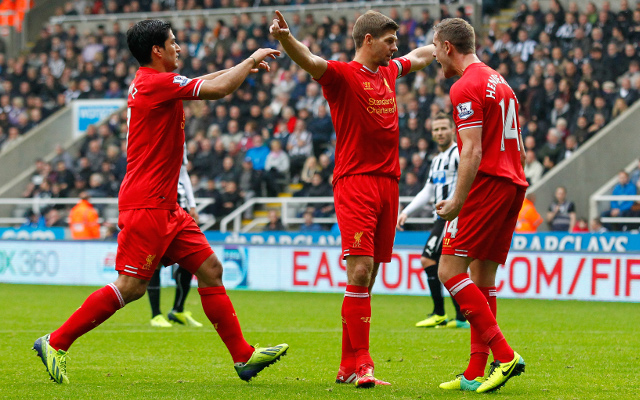Brendan Rodgers changes his formation because of Coutinho’s return to the lineup…
What was the difference?
While Brendan Rodgers has predominantly used a wing-back formation to accommodate the strike combination of Suarez and Sturridge this season, against Fulham on Saturday, he reverted to a 4-3-1-2 for the first time during his stint as Liverpool boss.
Liverpool were previously playing three centre-halves, with attacking wing-backs joining the midfield when the Reds were in possession. Against the Cottagers though, Rodgers swapped one of his centre-backs for an extra central midfielder, and it paid dividends.
Here’s how Liverpool roughly lined up:
Why did Rodgers use the 4-3-1-2?
Essentially, Rodgers needed to accommodate Coutinho in his starting lineup.
The little Brazilian has been out since September, and was making his first start since his return from a shoulder problem.
While he was sidelined, Liverpool struggled to link the midfield with the attack, and often relied on the brilliance of Saurez and Sturridge to score them goals.
With Coutinho back in the lineup though, the Reds have a technically outstanding player who can drift between the lines and create an outlet for both the defensive midfielders and the strikers.
Gerrard and Lucas can feed him the ball in tight situations – knowing he was the ability on the ball to maintain and recycle possession. Coutinho can also turn quickly and feed one of the strikers, who regularly make ambitious runs beyond the opposition defence.
What were the benefits?
The benefits of the new formation helped Liverpool’s midfield enormously.
Using the previous wing-back formation, the Reds deployed two centre-midfielders instead of three. With neither Gerrard or Lucas being especially mobile, they were often overran in the middle of the park as a result.
By deploying Lucas, Gerrard and Henderson as central midfielders though, the Reds dominated possession of the football. Henderson’s inclusion in a midfield three meant Gerrard and Lucas had less running to do, and the former could maximise his wonderful array of passing, while his Brazilian partner worked extremely intercept and tackle opponents.
Up top, Rodgers could also use his three best players in their favoured positions. Coutinho played as a no.10, so most of Liverpool’s attacks went straight through him. Last season, the Brazilian played on the left wing, and couldn’t dictate plays as easily, but shone at Anfield on Saturday in his pivotal role.
Suarez and Sturridge of course continued to dovetail in attack, and the Uruguayan bagged who lovely goals.
Potential problems:
While this formation has its obvious strengths, and maximises the players Rodgers has at his disposal, it also has drawbacks.
While Suarez and Sturridge are happy to come wide occasionally, the formation lacks any genuine width. This was ok at home, as Liverpool could carve open a hapless Fulham side through the middle, but it could make them look one dimensional against stronger sides.
It also means playing only two centre-backs. While strength in depth is a good thing, £18m signing Mamadou Sakho and in-form summer signing Kolo Toure could be starting on the bench due to Martin Skrtel’s great form and Daniel Agger’s return. This is without mentioning £7m August addition Tiago Ilori, who hasn’t had as much as a sniff of first-team action all season.
While the squad harmony seems brilliant at this point, without League Cup or Europa League football to rotate, some players could soon become disgruntled by a lack of playing time.
The verdict:
Positive, mainly.
By deploying the 4-3-1-2, Rodgers is using his best players in their proper positions, and also providing support for Gerrard and Lucas in midfield. While it lacks natural width, the Reds have attacking fullbacks who love getting forward, and Coutinho’s free role means he will be happy to drift into the channels.
It will be interesting to see how Rodgers lines Liverpool up following the international break…




COMMENTS